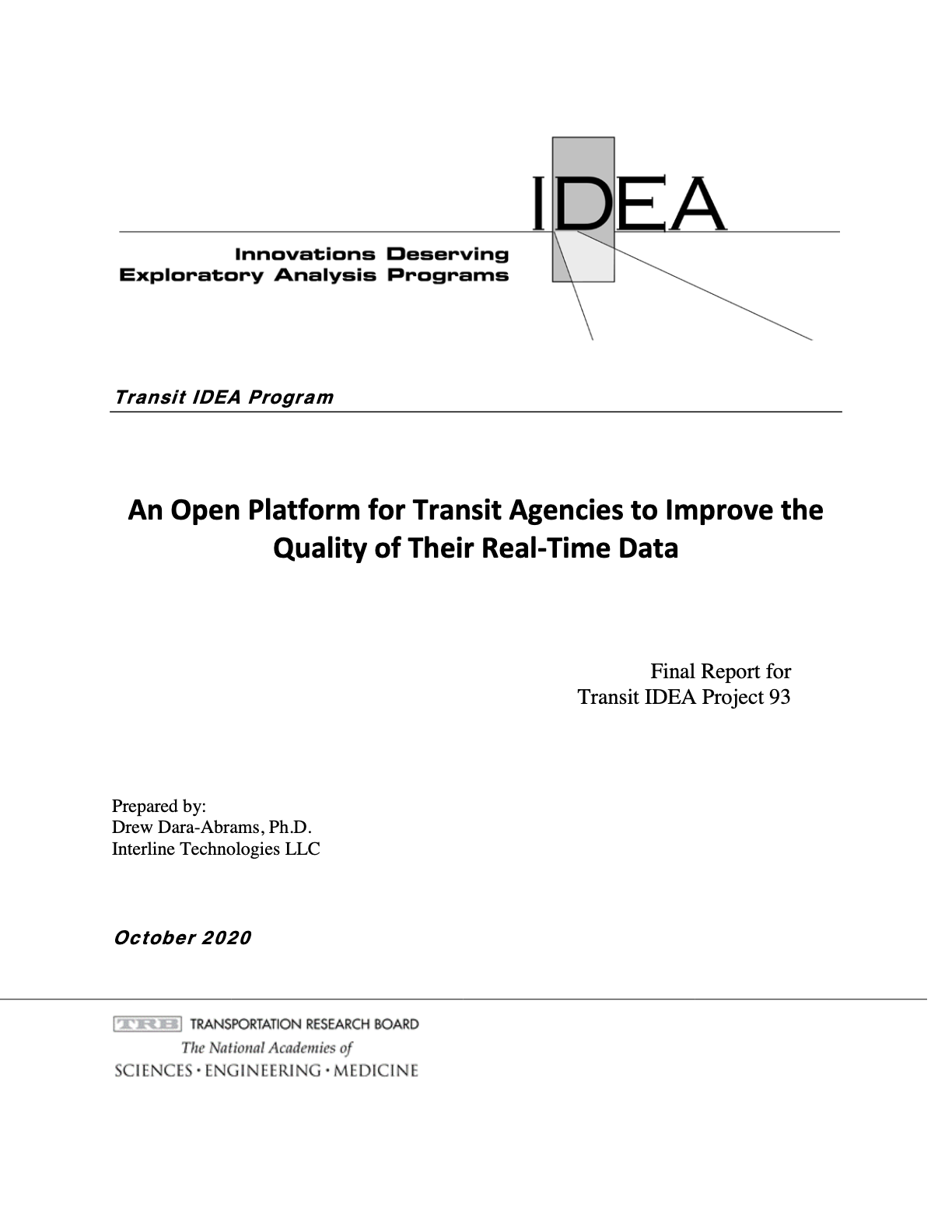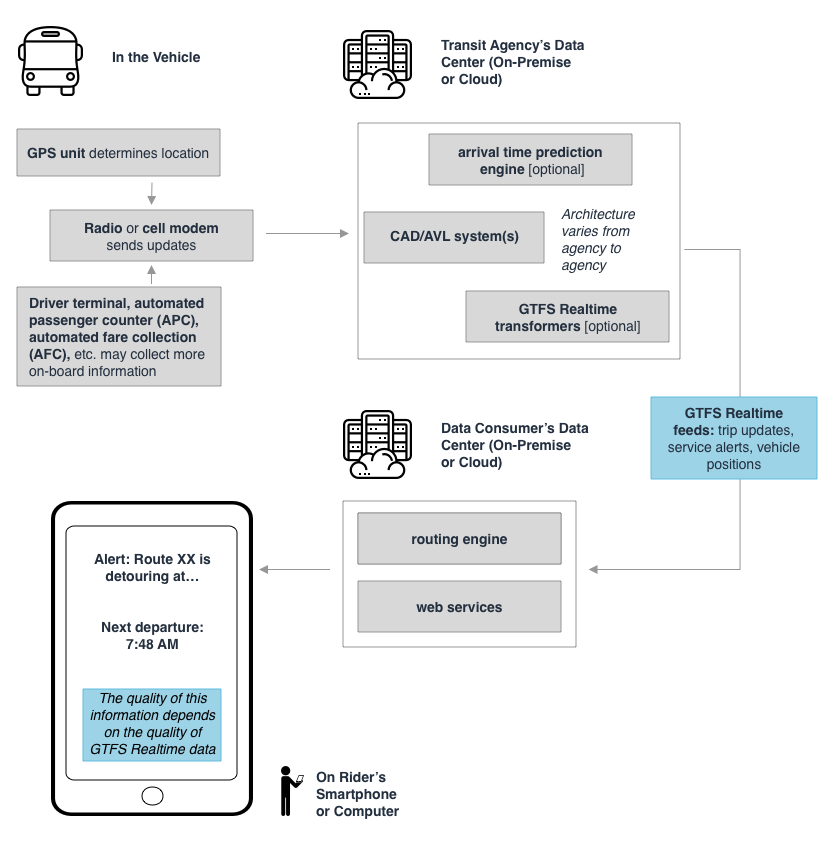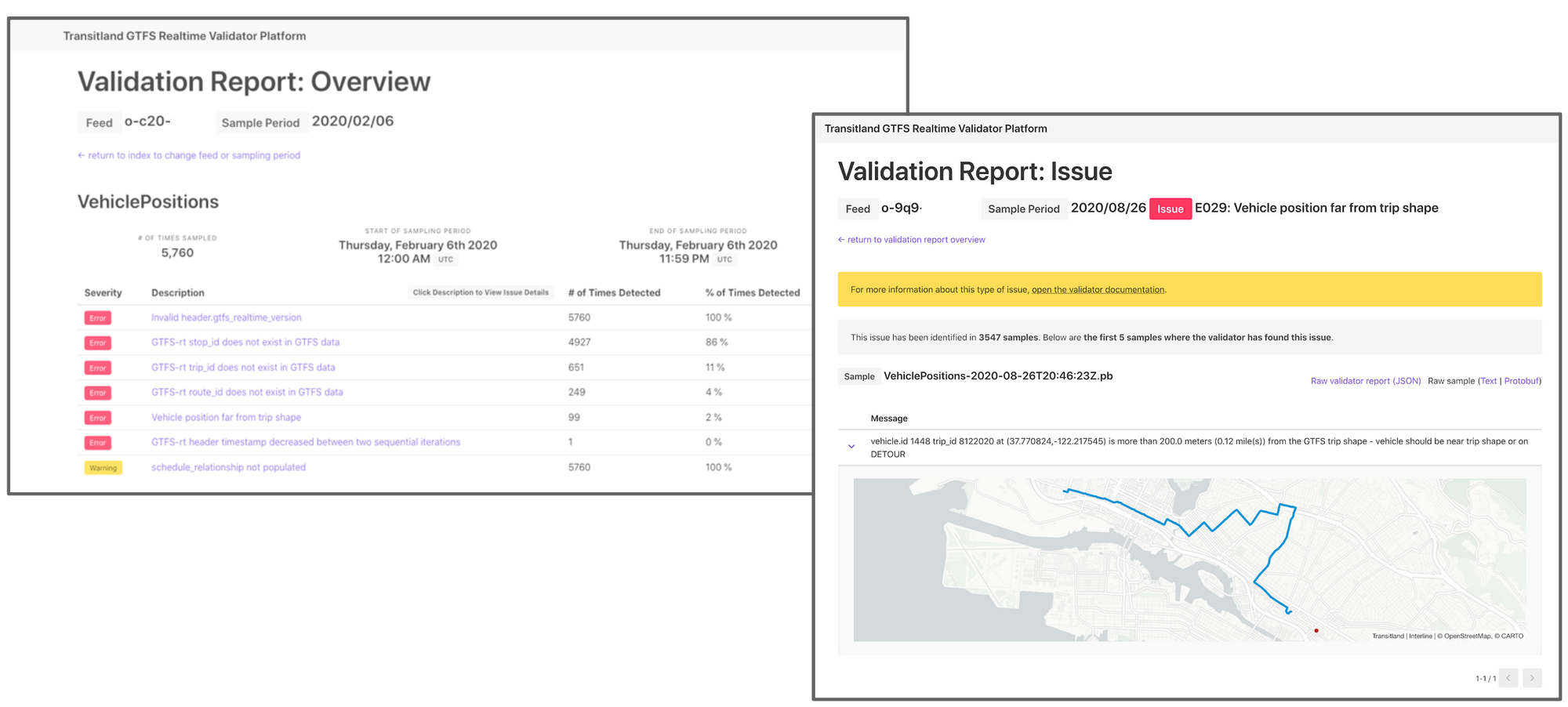In 2019 and 2020, Interline and the Center for Urban Transportation Research at University of South Florida collaborated on a Transit IDEA Program grant from the US Transportation Research Board. Our goal has been to help transit agencies to validate and improve the quality of their GTFS Realtime feeds. This first grant is now complete and TRB has published the full report with our findings and proposed next steps.

Executive Summary
Real-time transit information has been shown to have many benefits for transit riders and agencies, including shorter perceived and actual wait times, a more welcoming experience for new riders, and an increased feeling of safety, and increased ridership. Real-time transit data is, in comparison with many other potential operational or capital improvements to bus or rail service, an affordable means of increasing ridership. In the last few years, a real-time complement to the General Transit Feed Specification (GTFS) format, GTFS Realtime, has emerged, which enables transit agencies to share real-time predictions, vehicle positions, and service alert data in a standardized format. Despite its promise, adoption of GTFS Realtime by transit agencies has been hampered by readily available validation tools.

In this project, Interline Technologies LLC and the Center for Urban Transportation Research (CUTR) at the University of South Florida (USF) have created a prototype platform that makes GTFS Realtime validation tools readily available to, potentially, all transit agencies in North America. Our team is building upon two open-source projects: the GTFS Realtime validator prototype and Transitland, an open transit data platform. This project applies the open-source and open-data community models to the challenges of creating and improving GTFS Realtime data.
Stage 1: Build and Test GTFS Realtime Data Platform: The research team combined the Transitland open data platform, the GTFS Realtime Validator, and a list of 162 GTFS Realtime feed endpoints (provided by a partner organization). The combined platform collects GTFS Realtime data from each feed, runs the validator process, and produces a report on any detected errors. Each report shows the counts of data entities, the percentage with errors, and a brief text description of any errors. Links take users to additional documentation about each error type. Some errors also provide further contextual information in maps and tables to assist users as they try to determine root causes.

Stage 2: Testing and Expanding Catalogue: The project team has tested the platform by preparing validation reports for seven public-transit agencies and reviewing the results in the platform user interface with agency staff members over video calls. In these user-testing sessions, the project team collected information from agency staff about how GTFS and GTFS Realtime data are currently created at each agency, known issues, and any open goals. After being given a tour through the platform and its interface, agency staff reviewed the reports for their own GTFS Realtime feeds. Agency staff were asked to provide input on both the specific quality checks and the overall presentation and approach used by the platform with a standardized question list. The research team has summarized notes from the user-testing sessions and used these results to inform preliminary plans for expanding the platform for a wider range of users in the future.
Product Pay-Off Potential: By combining the open-source components of a GTFS Realtime validator with a catalog of GTFS Realtime feeds, hosted on Transitland’s cloud servers, this project will make the process of validating real-time data simple and accessible to agency staff from any computer with a web browser. As a result, GTFS Realtime data will improve in quality and availability. Transit riders will have a better experience (which has been linked to higher ridership), agency staff will provide better service with less effort and cost, and system vendors will provide a higher quality product.
Product Transfer: To succeed, this platform will need to be usable by agency staff and to provide them with results that they can act upon, both within the context of their agencies and with their vendors. Therefore, the project team has involved agency stakeholders early and often in the project. The team recruited nine transit agencies to write letters of support as part of the Transit IDEA proposal, and seven agencies have participated in our user-testing process. These agencies represent a diverse range of rider population sizes, staff skill level, and location (urban and rural). The final report includes information on immediate plans to continue and expand Transitland’s catalog GTFS Realtime feeds and longer term plans to develop a GTFS Realtime certification process supported by the platform.
Next Steps
We invite everyone to browse Transitland’s list of GTFS Realtime feeds. Please help us to maintain this list by contributing additions and edits to the open Transitland Atlas feed registry.
Do you work for a transit agency that publishes GTFS Realtime data? Please check to make sure it’s on Transitland. If not, please add it to the open Transitland Atlas feed registry or contact us for assistance.
Do you work for a transit agency that has issues with GTFS Realtime data, or do you represent a group with a stake in the future of GTFS Realtime data? We’re looking to collaborate on opening this GTFS Realtime validation platform for self-serve use by agencies. We welcome your interest.
Acknowledgements
Research team members include:
- Ian Rees, Interline, Principal
- Sean Barbeau, Center for Urban Transportation Research (CUTR), University of South Florida (USF), Principal Mobile Software Architect for R&D
Thanks to members of the T-93 expert review panel (ERP):
- Patricia Collette
- Stephen M. Stark
- Aaron Antrim
- Carol Schweiger
- Murat Omay
- Santosh Mishra
Many thanks to Velvet Basemera-Fitzpatrick, Ph.D., Transit IDEA Program Manager.
Thanks to the following transit agencies and staff members for participating in user testing:
- Metropolitan Transportation Commission (San Francisco): Nisar Ahmed
- Metro Transit (Minneapolis): Laura Matson, Mark DiPasquale, Gary Nyberg, Joey Reid, Juan Villanueva
- Massachusetts Bay Transportation Authority (Boston): Paul Swartz, Jessie, Richards, Logan Nash
- TriMet (Portland, Oregon): Mike Gilligan, Guy Tinat
- Tompkins Consolidated Area Transit (Ithaca, New York): Tom Clavel, Matthew Yarrow
- Washington Metropolitan Area Transit Authority (Washington, D.C.): Stephanie Jones, Richard Carman
- Hillsborough Area Regional Transit (Tampa, Florida): Dexter Corbin, William Mozel, Tim Wictor
- Rogue Valley Transportation District (Medford, Oregon): Melissa Lowry





